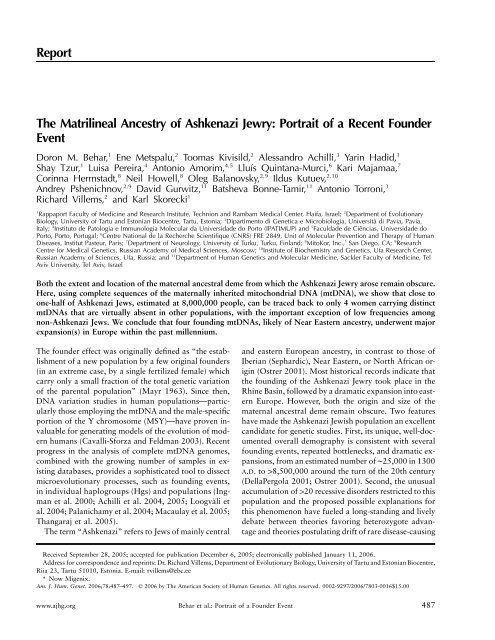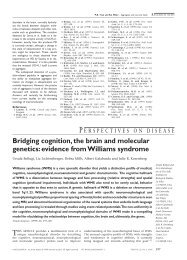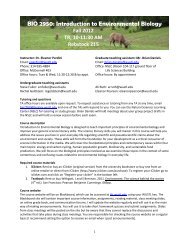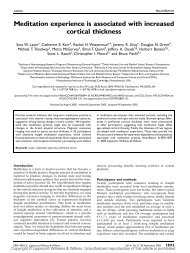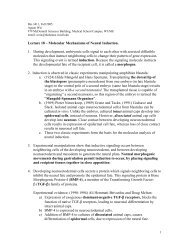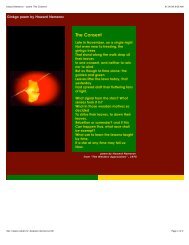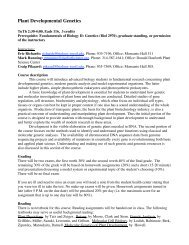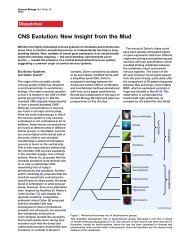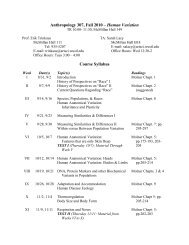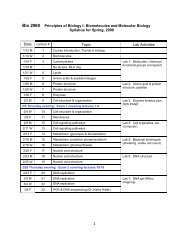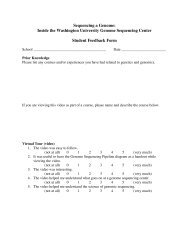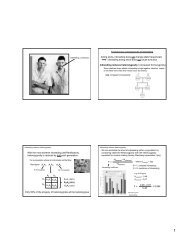Report The Matrilineal Ancestry of Ashkenazi Jewry: Portrait of a ...
Report The Matrilineal Ancestry of Ashkenazi Jewry: Portrait of a ...
Report The Matrilineal Ancestry of Ashkenazi Jewry: Portrait of a ...
Create successful ePaper yourself
Turn your PDF publications into a flip-book with our unique Google optimized e-Paper software.
<strong>Report</strong><strong>The</strong> <strong>Matrilineal</strong> <strong>Ancestry</strong> <strong>of</strong> <strong>Ashkenazi</strong> <strong>Jewry</strong>: <strong>Portrait</strong> <strong>of</strong> a Recent FounderEventDoron M. Behar, 1 Ene Metspalu, 2 Toomas Kivisild, 2 Alessandro Achilli, 3 Yarin Hadid, 1Shay Tzur, 1 Luisa Pereira, 4 Antonio Amorim, 4,5 Lluís Quintana-Murci, 6 Kari Majamaa, 7Corinna Herrnstadt, 8 Neil Howell, 8 Oleg Balanovsky, 2,9 Ildus Kutuev, 2,10Andrey Pshenichnov, 2,9 David Gurwitz, 11 Batsheva Bonne-Tamir, 11 Antonio Torroni, 3Richard Villems, 2 and Karl Skorecki 11Rappaport Faculty <strong>of</strong> Medicine and Research Institute, Technion and Rambam Medical Center, Haifa, Israel; 2 Department <strong>of</strong> EvolutionaryBiology, University <strong>of</strong> Tartu and Estonian Biocentre, Tartu, Estonia; 3 Dipartimento di Genetica e Microbiologia, Università di Pavia, Pavia,Italy; 4 Instituto de Patologia e Immunologia Molecular da Universidade do Porto (IPATIMUP) and 5 Faculdade de Ciências, Universidade doPorto, Porto, Portugal; 6 Centre National de la Recherche Scientifique (CNRS) FRE 2849, Unit <strong>of</strong> Molecular Prevention and <strong>The</strong>rapy <strong>of</strong> HumanDiseases, Institut Pasteur, Paris; 7 Department <strong>of</strong> Neurology, University <strong>of</strong> Turku, Turku, Finland; 8 MitoKor, Inc., * San Diego, CA; 9 ResearchCentre for Medical Genetics, Russian Academy <strong>of</strong> Medical Sciences, Moscow; 10 Institute <strong>of</strong> Biochemistry and Genetics, Ufa Research Center,Russian Academy <strong>of</strong> Sciences, Ufa, Russia; and 11 Department <strong>of</strong> Human Genetics and Molecular Medicine, Sackler Faculty <strong>of</strong> Medicine, TelAviv University, Tel Aviv, IsraelBoth the extent and location <strong>of</strong> the maternal ancestral deme from which the <strong>Ashkenazi</strong> <strong>Jewry</strong> arose remain obscure.Here, using complete sequences <strong>of</strong> the maternally inherited mitochondrial DNA (mtDNA), we show that close toone-half <strong>of</strong> <strong>Ashkenazi</strong> Jews, estimated at 8,000,000 people, can be traced back to only 4 women carrying distinctmtDNAs that are virtually absent in other populations, with the important exception <strong>of</strong> low frequencies amongnon-<strong>Ashkenazi</strong> Jews. We conclude that four founding mtDNAs, likely <strong>of</strong> Near Eastern ancestry, underwent majorexpansion(s) in Europe within the past millennium.<strong>The</strong> founder effect was originally defined as “the establishment<strong>of</strong> a new population by a few original founders(in an extreme case, by a single fertilized female) whichcarry only a small fraction <strong>of</strong> the total genetic variation<strong>of</strong> the parental population” (Mayr 1963). Since then,DNA variation studies in human populations—particularlythose employing the mtDNA and the male-specificportion <strong>of</strong> the Y chromosome (MSY)—have proven invaluablefor generating models <strong>of</strong> the evolution <strong>of</strong> modernhumans (Cavalli-Sforza and Feldman 2003). Recentprogress in the analysis <strong>of</strong> complete mtDNA genomes,combined with the growing number <strong>of</strong> samples in existingdatabases, provides a sophisticated tool to dissectmicroevolutionary processes, such as founding events,in individual haplogroups (Hgs) and populations (Ingmanet al. 2000; Achilli et al. 2004, 2005; Loogväli etal. 2004; Palanichamy et al. 2004; Macaulay et al. 2005;Thangaraj et al. 2005).<strong>The</strong> term “<strong>Ashkenazi</strong>” refers to Jews <strong>of</strong> mainly centraland eastern European ancestry, in contrast to those <strong>of</strong>Iberian (Sephardic), Near Eastern, or North African origin(Ostrer 2001). Most historical records indicate thatthe founding <strong>of</strong> the <strong>Ashkenazi</strong> <strong>Jewry</strong> took place in theRhine Basin, followed by a dramatic expansion into easternEurope. However, both the origin and size <strong>of</strong> thematernal ancestral deme remain obscure. Two featureshave made the <strong>Ashkenazi</strong> Jewish population an excellentcandidate for genetic studies. First, its unique, well-documentedoverall demography is consistent with severalfounding events, repeated bottlenecks, and dramatic expansions,from an estimated number <strong>of</strong> ∼25,000 in 1300A.D. to18,500,000 around the turn <strong>of</strong> the 20th century(DellaPergola 2001; Ostrer 2001). Second, the unusualaccumulation <strong>of</strong> 120 recessive disorders restricted to thispopulation and the proposed possible explanations forthis phenomenon have fueled a long-standing and livelydebate between theories favoring heterozygote advantageand theories postulating drift <strong>of</strong> rare disease-causingReceived September 28, 2005; accepted for publication December 6, 2005; electronically published January 11, 2006.Address for correspondence and reprints: Dr. Richard Villems, Department <strong>of</strong> Evolutionary Biology, University <strong>of</strong> Tartu and Estonian Biocentre,Riia 23, Tartu 51010, Estonia. E-mail: rvillems@ebc.ee* Now Migenix.Am. J. Hum. Genet. 2006;78:487–497. 2006 by <strong>The</strong> American Society <strong>of</strong> Human Genetics. All rights reserved. 0002-9297/2006/7803-0016$15.00www.ajhg.org Behar et al.: <strong>Portrait</strong> <strong>of</strong> a Founder Event 487
Table 1Control-Region Sequences and Hg Affiliation <strong>of</strong><strong>Ashkenazi</strong> mtDNAs<strong>The</strong> table is available in its entirety in the onlineedition <strong>of</strong> <strong>The</strong> American Journal <strong>of</strong> Human Genetics.alleles during the rapid population expansion that followedthe founding event (Diamond 1994; Risch et al.1995; Ostrer 2001). <strong>The</strong> published genetic data addressingthe question <strong>of</strong> a founding event in the maternalhistory <strong>of</strong> <strong>Ashkenazi</strong> Jews (Torroni et al. 1996; Thomaset al. 2002; Behar et al. 2004) are partially discordant,with some studies detecting a strong founder event (Torroniet al. 1996; Behar et al. 2004) and others reachingthe conclusion that there is little evidence for such anevent (Thomas et al. 2002). In particular, our recentanalysis <strong>of</strong> HVS-I sequences (Behar et al. 2004), extendedherein to a larger fraction <strong>of</strong> the control-region(16024–00300) variation in <strong>Ashkenazi</strong> Jews, has yieldeda broad range <strong>of</strong> Hgs well known to be prevalent andshared between Europe and the Near East and, therefore,not informative in determining the geographic origin <strong>of</strong>the population ancestral to contemporary <strong>Ashkenazi</strong>Jews (tables 1 and 2). Despite the presence <strong>of</strong> the entirerange <strong>of</strong> west Eurasian Hgs in the <strong>Ashkenazi</strong> mtDNApool, Hg frequencies clearly deviated from those reportedelsewhere for west Eurasian populations. Thisdeviation was due to a striking overrepresentation <strong>of</strong>Hgs K and N1b. However, since common Hgs coverlarge geographic areas and comprise numerous lineagesthat usually coalesced tens <strong>of</strong> thousands <strong>of</strong> years ago,monitoring their general frequencies does not effectivelyallow determination <strong>of</strong> the real number <strong>of</strong> ancestral maternallineages that gave rise to the present-day diversityin a population. <strong>The</strong>refore, although in previous studiesthe elevated frequencies <strong>of</strong> mtDNA Hgs K and N1b in<strong>Ashkenazi</strong> Jews suggested a maternal founding event(Torroni et al. 1996; Behar et al. 2004), the number <strong>of</strong>lineages within these Hgs, their putative origin, and theirlevel <strong>of</strong> restriction to <strong>Ashkenazi</strong> Jews remain to be resolved.To this end, in the current study, using completemtDNA sequence analysis, we identified the foundinglineages <strong>of</strong> <strong>Ashkenazi</strong> Hgs K and N1b and contrastedtheir variation against a global set <strong>of</strong> mtDNAs belongingto the same Hgs. On the basis <strong>of</strong> these data, we inferthe actual number, as well as the temporal and geographicorigin, <strong>of</strong> these maternal founders.We initially generated a maximum parsimony tree <strong>of</strong>121 complete mtDNA sequences belonging to Hg K. <strong>The</strong>tree encompassed 28 novel and 93 previously reportedmtDNAs (fig. 1 and table 3). <strong>The</strong> sequencing procedureand phylogeny construction were performed as describedin appendix A. Of the 28 novel samples, 13 werefrom <strong>Ashkenazi</strong> Jews, and 15 were selected from non-<strong>Ashkenazi</strong> Jews and non-Jewish Near Eastern populations.Samples for complete mtDNA sequencing werechosen to include the widest possible range <strong>of</strong> Hg Kinternal variation, on the basis <strong>of</strong> sequence analysis <strong>of</strong>the mtDNA control region. Figure 1 shows that Hg Ksplits at its root into two primary branches, K1 and K2.All 789 Hg K mtDNAs reported herein (table 4) weredesignated as either “K1” or “K2” (89% and 11%, respectively),revealing no additional branching at the root<strong>of</strong> K. Subhaplogroup (subHg) K2 is subdivided into twosubsequent major branches labeled “K2a” and “K2b,”whereas K1 splits into three branches—K1a, K1b, andK1c—that are defined by positions 497, 5913, and498del, respectively. All but one <strong>of</strong> the K1 mtDNAs reportedin this study belong to one <strong>of</strong> these threebranches. SubHg K1a encompassed most subbranchesand is also the dominant branch in our sample set, encompassing80% <strong>of</strong> all Hg K mtDNAs. <strong>The</strong> 13 <strong>Ashkenazi</strong>complete mtDNAs clustered into three distinctbranches in the phylogeny: K1a1b1a, K1a9, and K2a2a(fig. 1).K1a1b1a is marked by two coding-region transitions,10978 and 12954, and includes 14 <strong>of</strong> the 121 completesequences. Seven <strong>of</strong> these are reported for the first timeherein and are from <strong>Ashkenazi</strong> subjects, whereas theother seven were reported elsewhere as forming a specificcluster termed “K1a” (Herrnstadt et al. 2002). <strong>The</strong> ethnicitiesor religious affiliations <strong>of</strong> these seven subjects arenot available, but they were all collected in the UnitedStates and shared the control-region mutations with the<strong>Ashkenazi</strong> samples. Since the majority <strong>of</strong> contemporary<strong>Ashkenazi</strong> Jews reside in the United States, it is possiblethat this cluster represents a sample set <strong>of</strong> <strong>Ashkenazi</strong>Jews, though we have no way to confirm or refute this.K1a9 mtDNAs are marked only by the control-regiontransition 16524 but lack the diagnostic mutations <strong>of</strong>the other K1a2 through K1a8 subHgs (fig. 1). Six samplesbelong to this lineage—four <strong>of</strong> which, from <strong>Ashkenazi</strong>Jews, are reported herein for the first time. <strong>The</strong>other two mtDNAs were reported elsewhere, and thesame considerations noted for subHg K1a1b1a, withrespect to the ethnic or religious affiliation, also apply(Herrnstadt et al. 2002). K2a2a mtDNAs are markedby three coding-region transitions: 9254, 11348, and11914. Three mtDNAs belong to this lineage, two <strong>of</strong>which are from <strong>Ashkenazi</strong> individuals and are reportedherein for the first time. <strong>The</strong> third mtDNA was reportedTable 2Control-Region Haplotypes <strong>of</strong> <strong>Ashkenazi</strong> Hg KmtDNAs<strong>The</strong> table is available in its entirety in the onlineedition <strong>of</strong> <strong>The</strong> American Journal <strong>of</strong> Human Genetics.488 <strong>The</strong> American Journal <strong>of</strong> Human Genetics Volume 78 March 2006 www.ajhg.org
Table 3Source and Ethnic Origin <strong>of</strong> the 121 CompletemtDNA SequencesSample a Source PopulationD5939 Present article Algerian JewD1123 Present article <strong>Ashkenazi</strong> JewD1139 Present article <strong>Ashkenazi</strong> JewD1282 Present article <strong>Ashkenazi</strong> JewD1369 Present article <strong>Ashkenazi</strong> JewD1606 Present article <strong>Ashkenazi</strong> JewD1829 Present article <strong>Ashkenazi</strong> JewD4207 Present article <strong>Ashkenazi</strong> JewD4232 Present article <strong>Ashkenazi</strong> JewD4262 Present article <strong>Ashkenazi</strong> JewD4481 Present article <strong>Ashkenazi</strong> JewD4777 Present article <strong>Ashkenazi</strong> JewD5551 Present article <strong>Ashkenazi</strong> JewD5677 Present article <strong>Ashkenazi</strong> JewD5077 Present article CherkesD1311 Present article DruzeD1320 Present article DruzeD1626 Present article DruzeD1701 Present article DruzeD1520 Present article Moroccan JewD5908 Present article Moroccan JewD5257 Present article PalestinianD1435 Present article Yemenite JewD1656 Present article Yemenite JewD4757 Present article Yemenite JewE1089 Present article LebaneseE1221 Present article SaudiE1365 Present article SyrianA Achilli et al. 2005 ItalianH Herrnstadt et al. 2002 UnknownF Finnila et al. 2001 FinnishK Coble et al. 2004 UnknownMa Maca-Meyer et al. 2001 IberianMi Mishmar et al. 2003 UnknownP Palanichamy et al. 2004 IndianaSerial numbers <strong>of</strong> mtDNAs from the literaturewere not changed.elsewhere in the same U.S. data set (Herrnstadt et al.2002).After the delineation <strong>of</strong> the Hg K topology and in asearch for clues regarding the possible origin <strong>of</strong> the <strong>Ashkenazi</strong>lineages, 789 Hg K mtDNAs <strong>of</strong> a global set <strong>of</strong>13,359 samples (tables 5 and 6) were hierarchicallyscreened for polymorphisms relevant to include or excludethe samples from the three <strong>Ashkenazi</strong> K subbranches—K1a1b1a,K1a9, and K2a2a. <strong>The</strong> position <strong>of</strong>the three dominant <strong>Ashkenazi</strong> founding sequenceswithin the phylogenetic tree <strong>of</strong> 789 Hg K genomes isillustrated in figure 2. Of the 182 <strong>Ashkenazi</strong> Hg KmtDNAs, 179 could be readily assigned to K1a1b1a,K1a9, or K2a2a (table 6), demonstrating that virtuallyall Hg K genomes present in the <strong>Ashkenazi</strong> Jews belongto these three distinct monophyletic clades and, in turn,comprise 30% <strong>of</strong> all <strong>Ashkenazi</strong> maternal lineages. Of123 K1a1b1a mtDNAs (fig. 2 and table 6), 122 werefrom Jews—113 <strong>of</strong> <strong>Ashkenazi</strong> and 9 <strong>of</strong> Spanish-exileancestry (6 Bulgarian, 2 Italian, and 1 Turkish). <strong>The</strong> onlynon-Jewish K1a1b1a mtDNA that shared the HVS-Ihaplotype 16223-16224-16234-16311 with the <strong>Ashkenazi</strong>Jews was found in a subject from Hmelnitski, aUkrainian town with a major Jewish settlement until theSecond World War. As for K1a9, 48 <strong>of</strong> the 789 KmtDNAs were members <strong>of</strong> this subHg (fig. 2 and table6), and 47 were from Jews—41 <strong>Ashkenazi</strong>, 4 Spanishexile (2 Bulgarian, 1 former Yugoslavian, and 1 fromTurkey), 1 from Iraq, and 1 from Syria. A subHg K1a9mtDNA was found in one Hungarian <strong>of</strong> unidentifiedethnic or religious affiliation. Finally, 28 (25 <strong>Ashkenazi</strong>Jews, 1 Bulgarian Jew, 1 Georgian Jew, and 1 AzerbaijaniJew) <strong>of</strong> the 789 K samples belonged to subHg K2a2a(fig. 2 and table 6). This subHg and its parental Hg werenot found in any <strong>of</strong> 11,452 non-Jewish samples.<strong>The</strong> same principles were followed to investigate thehigh incidence <strong>of</strong> Hg N1b in <strong>Ashkenazi</strong> Jews. Hg N1bis virtually absent in Europeans but appears at frequencies<strong>of</strong> ∼3% or higher in those from Levant, Arabia, andEgypt (Richards et al. 2003; Kivisild et al. 2004; unpublishedresults <strong>of</strong> Tartu and Haifa groups). This Hgis defined by the transversion C16176G, relative to therevised Cambridge Reference Sequence (rCRS) (Andrewset al. 1999), and is reported in all non-Jewish Near EasternN1b mtDNAs. However, all but one <strong>of</strong> the <strong>Ashkenazi</strong>N1b mtDNAs were found to harbor a CrA transversionat nucleotide position 16176. To assess whetherthis was another <strong>Ashkenazi</strong> founding lineage, we followedthe same approach applied to Hg K. We randomlychose two mtDNAs for complete sequencing and identifiedseveral shared mutations that were absent in apreviously reported N1b complete sequence (Maca-Meyer et al. 2001) (fig. 3). We then examined nucleotidepositions 11928 and 12092—sites <strong>of</strong> two <strong>of</strong> the privatemutations—in 82 N1b mtDNAs that were available tous (table 7). Fifty-six <strong>of</strong> the 57 <strong>Ashkenazi</strong> Jews, the Spanish-exileJews, and the Moroccan Jew, who shared16176A, could be assigned to this same lineage. <strong>The</strong>single <strong>Ashkenazi</strong> and all other mtDNAs with 16176Gdid not harbor the mutations at 11928 and 12092. Curiously,the 16176A transversion probably occurredtwice in the phylogeny <strong>of</strong> N1b. Indeed, we have foundlineages with 16176A in Slavic-speaking populationsboth in the Balkans and in Ukraine, but these possessedHVS-I mutations different from those present among theJews, and they did not harbor the mutations at 11928and 12092; thus, they are clearly phylogenetically distinctfrom N1b genomes <strong>of</strong> the <strong>Ashkenazi</strong> Jews.In total, we have identified four <strong>Ashkenazi</strong> foundinglineages, three within Hg K and one in Hg N1b, derivingfrom only four ancestral women and accounting for fully40% <strong>of</strong> the mtDNAs <strong>of</strong> the current <strong>Ashkenazi</strong> popu-www.ajhg.org Behar et al.: <strong>Portrait</strong> <strong>of</strong> a Founder Event 489
Table 4Hg K Database<strong>The</strong> table is available in its entirety in the onlineedition <strong>of</strong> <strong>The</strong> American Journal <strong>of</strong> Human Genetics.Table 5Description <strong>of</strong> the Populations<strong>The</strong> table is available in its entirety in the onlineedition <strong>of</strong> <strong>The</strong> American Journal <strong>of</strong> Human Genetics.lation (∼8,000,000 people). <strong>The</strong> most dominant <strong>of</strong> theselineages, K1a1b1a, encompasses 62% <strong>of</strong> the <strong>Ashkenazi</strong>K mtDNAs, which translates into 19.4% <strong>of</strong> contemporary<strong>Ashkenazi</strong> Jews, or ∼1,700,000 people. <strong>The</strong> secondmost common lineage is within Hg N1b and correspondsto an additional 800,000 people. We comparedthe pattern <strong>of</strong> lineage distribution seen in <strong>Ashkenazi</strong> Jewswith a global database <strong>of</strong> ∼30,000 mtDNAs, 13,359 <strong>of</strong>which are from populations in which Hg K and N1bare present (table 6), and we could not detect anythingsimilar. For instance, in European populations, the closestthe existing literature <strong>of</strong>fers is the database <strong>of</strong> 192complete Finnish mtDNA sequences (Finnila et al.2001). Though these mtDNAs were nonrandomly selectedfrom a larger control-region database <strong>of</strong> nearly500 individuals living in a north-central region <strong>of</strong> Finland,a typical, frequently derived, phylogenetically recentlineage comprises merely 3%–4% <strong>of</strong> the total. Inthe study <strong>of</strong> Coble et al. (2004), the entire mtDNA sequences<strong>of</strong> 241 individuals matching 1 <strong>of</strong> the 18 mostcommon control-region haplotypes in European Caucasianpopulations were determined. <strong>The</strong> frequency <strong>of</strong>these 18 haplotypes was found to account for only20.8% <strong>of</strong> the European Caucasian mtDNAs—a very significantdifference compared with the <strong>Ashkenazi</strong> Jews,for which four complete sequence haplotypes comprise42% <strong>of</strong> the mtDNAs. Furthermore, even mtDNAs withthe same control-region motif were rarely found to completelymatch at the coding-region level, with an averagecoding-region mismatch <strong>of</strong> 6.2 mutations observedwithin the 241 completely sequenced mtDNAs. Thiswould correspond to an approximate average date <strong>of</strong>15,000–16,000 years ago for the most recent commonancestor, under the same assumptions used to calculatethe coalescence <strong>of</strong> the <strong>Ashkenazi</strong> lineages (see below).<strong>The</strong>refore, in contrast to Thomas et al. (2002), we concludethat a significant founding event is, indeed, readilyevident in the maternal history <strong>of</strong> <strong>Ashkenazi</strong> Jews. Thomaset al. (2002) based their analysis on a portion <strong>of</strong>the HVS-I region (nucleotide positions 16093–16383)from 78 subjects and, in contrast to Torroni et al. (1996)and Behar et al. (2004), reported that the most frequentsequence found in their <strong>Ashkenazi</strong> sample (their “modalhaplotype”) is identical to the HVS-I sequence <strong>of</strong> the socalledrCRS, with a frequency not significantly differentfrom that observed among their European host populations.However, it is now well established that therCRS sequence in HVS-I can be found in several differentHgs—H, HV, pre-HV, U, and a paraphyletic group R*.Thus, although the inference by Thomas et al. (2002)soundly emanates from the results <strong>of</strong> their limited samplesize and subfragment analysis, the conclusion reached isnot borne out with the use <strong>of</strong> control-region analysis ina larger sample set. Moreover, even under the improbableassumption that all rCRS mtDNAs studied by Thomaset al. (2002) belonged to Hg H, additional genealogicalresolution is not provided, since such a motif canbe found in a diverse variety <strong>of</strong> subclades <strong>of</strong> Hg H, many<strong>of</strong> which diverged from a common ancestor 110,000years ago (Finnila et al. 2001; Herrnstadt et al. 2002;Achilli et al. 2004; Loogväli et al. 2004; Pereira et al.2005), a time frame uninformative for studying recentancestries in general and the founding <strong>of</strong> the <strong>Ashkenazi</strong>population in particular. Complete sequencing <strong>of</strong> Ash-Figure 1 Most parsimonious tree <strong>of</strong> complete Hg K mtDNA sequences. <strong>The</strong> tree is rooted in Hg U* and includes 121 mtDNAs, <strong>of</strong> which28 are novel and 93 were reported elsewhere (12 sequences from Finnila et al. [2001], 1 from Maca-Meyer et al. [2001], 47 from Herrnstadtet al. [2002] [including the control-region information that was not reported], 1 from Mishmar et al. [2003], 28 from Coble et al. [2004], 2from Palanichamy et al. [2004], and 2 from Achilli et al. [2005]). <strong>The</strong> genotyping information from Finnila et al. (2001) included herein correctsseveral inaccuracies that were reported elsewhere for the control-region phylogeny. Mutations are shown on the branches and are transitionsunless the base change is explicitly indicated. Deletions are indicated by a “D” following the deleted nucleotide position. Insertions are indicatedby a dot followed by the number and type <strong>of</strong> inserted nucleotide(s). Underlined nucleotide positions occur at least twice in the tree. An asterisk(*) at the end <strong>of</strong> a nucleotide position denotes a reversion. <strong>The</strong> information <strong>of</strong> the reported samples is presented in table 3. Samples in blueare from <strong>Ashkenazi</strong> Jews. Nucleotide positions in red were assayed in the entire set <strong>of</strong> 789 mtDNAs belonging to K. To resolve three possiblereticulations, reversions at nucleotide 7082 in sample A01 and nucleotides 10398 and 11485 in sample H510 and a homoplasy at nucleotide7927 for subHg K1a1a and K1a8 were assumed. <strong>The</strong> tree was drawn by hand from networks constructed using program Network 4.1.0.0.We applied the reduced-median algorithm ( r p 2) followed by the median-joining algorithm ( e p 2), as described at the Fluxus EngineeringWeb site. <strong>The</strong> control-region positions were tw<strong>of</strong>old down-weighted, with respect to coding-region positions. <strong>The</strong> hypervariable nucleotides16182 and 16183 in HVS-I and the indels at nucleotides 309, 315, and 524 in HVS-II were excluded. Coding-region mutations at nucleotides750, 1438, 1811, 2706, 4769, 7028, 8860, 11467, 11719, and 12308 are not shown unless reverted. Ethnic designation <strong>of</strong> the sequences wasavailable for the sequences reported by Finnila et al. (2001), Maca-Meyer et al. (2001), Palanichamy et al. (2004), and Achilli et al. (2005),and for the novel samples reported herein (table 3).www.ajhg.org Behar et al.: <strong>Portrait</strong> <strong>of</strong> a Founder Event 491
Table 6SubHg Affiliation <strong>of</strong> the 789 mtDNAs Belonging to K<strong>The</strong> table is available in its entirety in the onlineedition <strong>of</strong> <strong>The</strong> American Journal <strong>of</strong> Human Genetics.kenazi mtDNA genomes with the rCRS sequence motifin their HVS-I region, as demonstrated for Hg K andN1b in the current study, would be a straightforwardapproach to reveal additional maternal founder lineagesamong such mtDNAs.<strong>The</strong> coalescence time for each <strong>of</strong> the four lineages wascalculated independently in two ways: from HVS-I andfrom the entire coding-region sequence (table 8). Whenwe analyzed the coding-region data, we used only theinformation obtained from the novel complete mtDNAgenomes in which <strong>Ashkenazi</strong> ancestry was firmly established(table 1). Historical records suggest the establishment<strong>of</strong> the <strong>Ashkenazi</strong> population during the 7th and8th centuries in the Rhine valley by a few migratingfamilies arriving from northern Italy (Ostrer 2001). <strong>The</strong>estimated number <strong>of</strong> <strong>Ashkenazi</strong> Jews in the 12th and13th centuries is 25,000, a number sufficient to keepallelic frequencies largely in balance against random geneticdrift within ∼30–40 generations. <strong>The</strong>refore, thedemographic history suggests that the crucial founderevents are likely to have occurred sometime before the12th century, whereas the expansion phase <strong>of</strong> <strong>Ashkenazi</strong><strong>Jewry</strong> in Europe, with its ups and downs, has lasted morethan a millennium. Our coalescence analysis is in agreementwith this assumption, since the expansion timecalculations for the four <strong>Ashkenazi</strong> lineages point to thepast 20 centuries and are close to the historical foundingperiod <strong>of</strong> the <strong>Ashkenazi</strong> population. It should be notedthat, despite relatively large SDs, the coalescence timeestimates for the four maternal founder <strong>Ashkenazi</strong> lineagesare at least an order <strong>of</strong> magnitude lower than thoseobtained for the corresponding parental clades, whichclearly signals a recent beginning <strong>of</strong> their expansion.<strong>The</strong>re are two fundamental questions with respect tothe geographic origin <strong>of</strong> the <strong>Ashkenazi</strong> founding lineages.First, were these lineages a part <strong>of</strong> the mtDNApool <strong>of</strong> a population ancestral to <strong>Ashkenazi</strong> Jews in theNear East, or were they established within the <strong>Ashkenazi</strong>Jews later in Europe, as a result <strong>of</strong> introgression fromEuropean or Eurasian groups? Second, where did theselineages expand? <strong>The</strong> observed global pattern <strong>of</strong> distributionrenders very unlikely the possibility that the fouraforementioned founder lineages entered the <strong>Ashkenazi</strong>mtDNA pool via gene flow from a European host population.For example, in databases <strong>of</strong> HVS-I sequences<strong>of</strong> British, Irish, German, French, or Italian subjects,these <strong>Ashkenazi</strong> sample founder lineage sequences werenot observed (Baasner et al. 1998; Lutz et al. 1998;Pfeiffer et al. 2001). Furthermore, the non-<strong>Ashkenazi</strong>Jewish populations sharing the <strong>Ashkenazi</strong> mtDNA HgK lineages turn out to be from Jewish communities thattrace their origins to the expulsion from Spain in 1492.Either a shared ancestral origin <strong>of</strong> the two groups or,alternatively, a postexile admixture between neighboring<strong>Ashkenazi</strong> and Spanish-exile Jewish populations may explainthe sharing <strong>of</strong> these maternal lineages. However,the very presence <strong>of</strong> the <strong>Ashkenazi</strong> founding lineages,albeit at low frequencies, in North African, Near Eastern,and Caucasian Jews, supports a common Levantineancestry. <strong>The</strong> maternal subclade from which the <strong>Ashkenazi</strong>mtDNA lineage K2a2a arose was not found inany other <strong>of</strong> the populations reported herein (table 6).<strong>The</strong> <strong>Ashkenazi</strong> K1a9 and K1a1b1a lineages were notfound in non-Jews, with the exception <strong>of</strong> the former ina single Hungarian and the latter in a single Ukrainian,both <strong>of</strong> unknown ethnicity. However, it is <strong>of</strong> interestthat K1a1b1a sister lineages, which share with it a commonancestry at the internal nodal level <strong>of</strong> subcladeK1a1b1 (fig. 2), can be found in Portugal, Italy, France,Morocco, and Tunisia (table 6). This reveals that thisparticular limb <strong>of</strong> the Hg K phylogenetic tree is <strong>of</strong> awider Mediterranean presence and origin. Likewise, thedistribution <strong>of</strong> Hg N1b in southwestern Asia and NorthAfrica (Rando et al. 1998; Richards et al. 2000) supportsa Near Eastern, rather than a European, origin for thisHg. It is noteworthy that our extensive sample set fromthe Caucasus (table 5) does not <strong>of</strong>fer any hint that thefour dominant <strong>Ashkenazi</strong> mtDNA lineages might havearrived from this region. However, it can be concludedthat, irrespective <strong>of</strong> where exactly the mutations definingthese <strong>Ashkenazi</strong> lineages arose, their expansion clearlytook place during the time period <strong>of</strong> the sojourn <strong>of</strong> the<strong>Ashkenazi</strong> population in Europe.It is important to note that, although our findingsclarify the restricted nature <strong>of</strong> mtDNA lineage diversitycarried by <strong>Ashkenazi</strong> <strong>Jewry</strong> and provide evidence <strong>of</strong> afounder event specifically for the matrilineal ancestry,some questions remain unsolved and could be the focus<strong>of</strong> future studies. First, our findings are not sufficient toanswer questions about the extent and location <strong>of</strong> theancestral deme from which <strong>Ashkenazi</strong> <strong>Jewry</strong>, as a population,arose. It is possible that, for the MSY and autosomalloci, different patterns might be observed. Second,our findings cannot provide a quantitative assessment<strong>of</strong> the <strong>Ashkenazi</strong> population bottleneck, becausethe fraction <strong>of</strong> the ancestral maternal deme representedby the four particular founding lineages thatwe have identified cannot be determined. Third, the ef-Table 7N1b Haplotypes in Jews and Near Eastern Non-Jews<strong>The</strong> table is available in its entirety in the onlineedition <strong>of</strong> <strong>The</strong> American Journal <strong>of</strong> Human Genetics.492 <strong>The</strong> American Journal <strong>of</strong> Human Genetics Volume 78 March 2006 www.ajhg.org
Figure 2 <strong>The</strong> location <strong>of</strong> the three <strong>Ashkenazi</strong> lineages (light blue) belonging to Hg K in a global set <strong>of</strong> complete K sequences. For thenetwork construction, first, a topology network encompassing the 91 branches found in the total set <strong>of</strong> 121 complete K sequences was drawnusing the same principles described in figure 1. For simplicity, we used only one complete mtDNA sequence per node, and we indicate onlythe coding-region nucleotide positions that are relevant in the context <strong>of</strong> the three <strong>Ashkenazi</strong> lineages K1a1b1a, K1a9, and K2a2a, with theexception <strong>of</strong> positions 497, 498D, and 16524, which define K1a, K1c, and K1a9, respectively. Branch lengths were sometimes distorted toincrease legibility. <strong>The</strong>n, the topology network was compared with a second phylogenetic tree <strong>of</strong> the entire set <strong>of</strong> 789 K mtDNAs analyzedhierarchically for the diagnostic mutations (red). All Jews <strong>of</strong> North African, Caucasian, Near Eastern, and Spanish-exile ancestry were aggregatedinto the category <strong>of</strong> “non-<strong>Ashkenazi</strong> Jews.” Likewise, all non-Jewish samples from Anatolia, the Caucasus, central and southwestern Asia, andthe Near East were aggregated into the category <strong>of</strong> “West Asia.” Circle sizes are proportional to the haplotype frequency in the sample.fects on the nuclear genome <strong>of</strong> the maternal foundingevent, whose mtDNA population genetic imprint wehave observed, is influenced by other parameters, suchas admixture, recombination events, and paternal contribution,that have occurred through the generations.<strong>The</strong> quantitative contribution <strong>of</strong> each <strong>of</strong> these parametersis not known, and these are likely to result in adifferent pattern for the nuclear genome, compared withthat <strong>of</strong> mtDNA. Nevertheless, the analysis <strong>of</strong> mtDNAsequence variation enables the detailed and quantitativeelucidation <strong>of</strong> a maternal founder event, which cannotbe inferred from analysis <strong>of</strong> other genomic regions.In conclusion, the present study highlights the importance<strong>of</strong> a combined phylogenetic/phylogeographicstrategy that includes complete mtDNA sequence analysisto accurately portray maternal founding events andto infer conclusions relevant to both shared ancestriesand population-level effects that shaped the mtDNAgene pool in a given population. In the <strong>Ashkenazi</strong> Jews,this approach enabled us to reconstruct a detailed phylogenetictree for the major <strong>Ashkenazi</strong> Hgs K and N1b,allowing the detection <strong>of</strong> a small set <strong>of</strong> only four individualfemale ancestors, likely from a Hebrew/LevantinemtDNA pool, whose descendants lived in Europe andcarried forward their particular mtDNA variants to3,500,000 individuals in a time frame <strong>of</strong> !2 millennia.This founding event(s), established here as a dominantmechanism in the genetic maternal history <strong>of</strong> the <strong>Ashkenazi</strong>Jews, is a vivid example <strong>of</strong> the founder effectoriginally described by Mayr (1963) 4 decades ago.www.ajhg.org Behar et al.: <strong>Portrait</strong> <strong>of</strong> a Founder Event 493
Table 8Coalescence Ages <strong>of</strong> the Four Major <strong>Ashkenazi</strong> mtDNA LineagesHg AND SubHgAGE aSD bN r Years j YearsHVS-I:K1a1b1a:16224 16234 16311 46 .09 1,755 .04 87716223 16224 16234 16311 67 .16 3,313 .07 1,506K1a9:16224 16311 5 0 0 .20 4,03616093 16224 16311 36 0 0 .03 561K2a2a:16224 16311 25 .08 1,614 .06 1,142N1b:16145 16176A 16223 56 .04 721 .03 510Coding region:K1a1b1a:Entire branch 14 .36 1,835 .16 821<strong>Ashkenazi</strong> 7 .14 742 .14 742K1a9:Entire branch 6 .33 1,713 .24 1,211<strong>Ashkenazi</strong> 4 .50 2,569 .35 1,816K2a2a:<strong>Ashkenazi</strong> 2 0 0 .50 2,569N1b:<strong>Ashkenazi</strong> 2 0 0 .50 2,569aCoalescence time was calculated by considering one transition betweennucleotides 16090–16365 (HVS-I) equal to 20,180 years (Forsteret al. 1996) and one base substitution between nucleotides 577–16023 (coding region) equal to 5,138 years (Mishmar et al. 2003).bSD <strong>of</strong> the r estimate (j) was calculated as reported elsewhere(Saillard et al. 2000).Figure 3 Most parsimonious tree <strong>of</strong> complete Hg N1b mtDNAsequences. <strong>The</strong> tree encompasses the two complete <strong>Ashkenazi</strong> N1bsequences and one previously published sequence (Maca-Meyer et al.2001). <strong>The</strong> same considerations detailed in figure 1 are relevant here.Nucleotide positions 11928 and 12092 (bold) were examined in allN1b mtDNAs.AcknowledgmentsWe thank the individuals who provided samples for thisstudy, the National Laboratory for the Genetics <strong>of</strong> Israeli Populations,which also provided samples, and Vered Friedmanand Guennady Yudkovsky for technical assistance. This researchwas supported in part by Israeli Science Foundationgrants (to K.S.), the Annie Chutick Endowment and Technion(to K.S.), the Estonian Science Foundation (to E.M. and T.K.),European Union Framework Programme Genemill and Generagrants (to R.V.), the Consiglio Nazionale della Ricerche–Ministrodell’Istruzione dell’Univerita e della Ricerca (CNR-MIUR) Genomica Funzionale-Legge 449/97 (to A.T.), theFondo Investimenti Ricerca di Base 2001 (to A.T.), the ProgettiRicerca Interesse Nazionale 2005 (to A.T.), the National ScienceFoundation (to N.H.), and Programa Operacional Ciência,Tecnologia e Inovação (to A. Amorim).Appendix AMethodsSamplingA total <strong>of</strong> 583 <strong>Ashkenazi</strong> Jewish and 1,111 non-<strong>Ashkenazi</strong>Jewish samples were analyzed for mtDNA Hgspecificmarkers, identifying 186 and 63 samples, respectively,belonging to Hg K (HVS-I data for 565 <strong>of</strong>the <strong>Ashkenazi</strong> samples have been reported elsewhere [Beharet al. 2004]). Of the 186 samples found among <strong>Ashkenazi</strong>Jews and the 63 Hg K samples found among non-<strong>Ashkenazi</strong> Jews, 182 and 62, respectively, were availablefor further genotyping. Next, we identified Hg K samplesin all population sample collections available from thelaboratories in Haifa, Tartu, Pavia, Porto, and Paris, andwe reported only populations in which Hg K sampleswere found and available for further genotyping. Weevaluated a total <strong>of</strong> 11,452 samples from 67 populationsand identified 636 Hg K samples, 545 <strong>of</strong> which wereavailable for further genotyping. Table 5 details the totalnumber <strong>of</strong> samples available from each population, the494 <strong>The</strong> American Journal <strong>of</strong> Human Genetics Volume 78 March 2006 www.ajhg.org
number <strong>of</strong> Hg K samples within each population, thenumber <strong>of</strong> Hg K samples from each population that weretechnically available for genotyping in this study, thereporting laboratory, and the first study in which thesamples were reported (Bermisheva et al. 2002; Beharet al. 2004; Pereira et al. 2004; Quintana-Murci et al.2004). We then examined the same data set <strong>of</strong> Jewishsamples described above for the presence <strong>of</strong> Hg N1bsamples and identified a total <strong>of</strong> 57 and 11 Hg N1bsamples in <strong>Ashkenazi</strong> and non-<strong>Ashkenazi</strong> Jews, respectively.We also reported the results <strong>of</strong> 14 Hg N1b samplesfound in the same Druze, Palestinian, and Bedouin samplesincluded in the sample set described above (table5), and we compared the <strong>Ashkenazi</strong> N1b Hg mtDNAswith the unpublished database <strong>of</strong> 8,644 Caucasian, European,Near and Middle Eastern, and North Africansubjects included in this study and available in Tartu(table 5). All samples reported herein were derived fromblood, buccal swab, or blood cell samples that werecollected with informed consent, in accordance with proceduresapproved by institutional human subjects reviewcommittees in their respective locations. All subjects reportedthe birthplace <strong>of</strong> their mothers, grandmothers,and, in most cases, great-grandmothers.Control-Region SequencingSequences <strong>of</strong> the control region were determined fromposition 16024 to 00300, by use <strong>of</strong> the ABI Prism DyeTerminator cycle-sequencing protocols developed by AppliedBiosystems (Perkin-Elmer). Control-region sequencedata were used to define haplotypes within the Hgs. <strong>The</strong>control-region information reported from Haifa andParis extends from 16024 to 00300. <strong>The</strong> control-regioninformation reported from Tartu spans from 16024 to16400, corresponding to HVS-I. <strong>The</strong> control-region informationreported from Pavia extends from 16024 toat least 00200 and, in most cases, up to 00300. <strong>The</strong>control-region information reported from Porto extendsfrom 16024 to 16365 and from 00072 to 00340. <strong>The</strong>hypervariable positions 16182 and 16183 in HVS-I andthe indels at positions 00309 and 00315 in HVS-II wereexcluded from the analysis (tables 1 and 4).Complete mtDNA SequencingDNA was amplified using 18 primers to yield nineoverlapping fragments, as reported elsewhere (Taylor etal. 2001). After purification, the nine fragments weresequenced by means <strong>of</strong> 56 internal primers to obtain thecomplete mtDNA genome. Sequencing was performedon a 3100 DNA Analyzer (Applied Biosystems), and theresulting sequences were analyzed with the SEQUEN-CHER s<strong>of</strong>tware. Mutations were scored relative to therCRS (Andrews et al. 1999). <strong>The</strong> novel 28 Hg K and 2N1b complete mtDNA sequences reported herein havebeen submitted to GenBank (accession numbersDQ301789–DQ301818). Quality control was assuredas follows: first, each base pair was determined oncewith a forward and once with a reverse primer; second,any ambiguous base call was tested by additional andindependent PCR and sequencing reactions; and third,all sequences were examined by two independentinvestigators.Hg LabelingAll Hg K samples reported herein harbored the diagnosticmarker G9055A, as confirmed by the RFLPreaction 9052HaeII. Diagnostic markers for genotypingsubclades <strong>of</strong> Hg K were selected on the basis <strong>of</strong> theanalyses <strong>of</strong> the complete mtDNA sequences. Positions295, 497, 498, 1189, 4561, 7927, 8697, 8703, 8790,9254, 9647, 9716, 10398, 11025, 11914, 13117,11470, 11485, 15924, 10978, and 12954 were obtainedby direct sequencing. Positions 1189, 5913, 9716,10398, and 11914 were obtained by direct sequencingor by means <strong>of</strong> RFLPs 1186RsaI, 5913HaeIII,9714BsaI, 10398DdeI, and 11914TaiI or11911HpyCH4IV, respectively. All Hg N1b samplesreported herein harbored the diagnostic markerT10238C, as confirmed by 10237HphI. Two diagnosticpositions, 11928 and 12092, derived from thecomplete mtDNA sequences analysis <strong>of</strong> the two Hg N1bsamples, were examined by direct sequencing in all Jewish,Druze, Palestinian, and Bedouin samples.NomenclatureWe followed a consensus Hg nomenclature scheme(Richards et al. 1998). Numbers 1–16569 refer to theposition <strong>of</strong> the mutation in the rCRS (Andrews et al.1999). We use the term “lineage” to denote a cluster <strong>of</strong>related, evolving haplotypes within an Hg. Note thathaplotypes and lineages can relate to HVS-I, to the controlregion, or to the complete mtDNA sequence data.Nomenclature within Hg K has been the subject <strong>of</strong> someambiguity because <strong>of</strong> the recycling <strong>of</strong> the designation“K1a” (Herrnstadt et al. 2002; Palanichamy et al. 2004).We followed the definitions <strong>of</strong> both publications for“K1” and “K2.” We followed Palanichamy et al. (2004)for the definitions <strong>of</strong> “K1a,” “K1a1,” “K1a2,” “K1b,”“K1c,” and “K2a” and corrected in this article a fewinaccuracies reported for the samples labeled “SF#153”and “CH#365.” Herrnstadt et al. (2002) used the designation<strong>of</strong> “K1a” for one subHg <strong>of</strong> K. To avoid confusionand because this lineage was found to be highlyimportant in the current study, we specifically note thatwe assigned to this lineage the more detailed designation“K1a1b1a.”www.ajhg.org Behar et al.: <strong>Portrait</strong> <strong>of</strong> a Founder Event 495
Web ResourcesAccession numbers and URLs for data presented herein are asfollows:Fluxus Engineering Web site, http://www.fluxus-engineering.com/GenBank, http://www.ncbi.nlm.nih.gov/Genbank/ (for the completemtDNA sequences [accession numbers DQ301789–DQ301818])ReferencesAchilli A, Rengo C, Battaglia V, Pala M, Olivieri A, Fornarino S, MagriC, Scozzari R, Babudri N, Santachiara-Benerecetti AS, Bandelt HJ,Semino O, Torroni A (2005) Saami and Berbers: an unexpectedmitochondrial DNA link. Am J Hum Genet 76:883–886Achilli A, Rengo C, Magri C, Battaglia V, Olivieri A, Scozzari R,Cruciani F, Zeviani M, Briem E, Carelli V, Moral P, Dugoujon JM,Roostalu U, Loogvali EL, Kivisild T, Bandelt HJ, Richards M, VillemsR, Santachiara-Benerecetti AS, Semino O, Torroni A (2004)<strong>The</strong> molecular dissection <strong>of</strong> mtDNA haplogroup H confirms thatthe Franco-Cantabrian glacial refuge was a major source for theEuropean gene pool. Am J Hum Genet 75:910–918Andrews RM, Kubacka I, Chinnery PF, Lightowlers RN, Turnbull DM,Howell N (1999) Reanalysis and revision <strong>of</strong> the Cambridge referencesequence for human mitochondrial DNA. Nat Genet 23:147Baasner A, Schafer C, Junge A, Madea B (1998) Polymorphic sites inhuman mitochondrial DNA control region sequences: populationdata and maternal inheritance. Forensic Sci Int 98:169–178Behar DM, Hammer MF, Garrigan D, Villems R, Bonne-Tamir B,Richards M, Gurwitz D, Rosengarten D, Kaplan M, Della PergolaS, Quintana-Murci L, Skorecki K (2004) MtDNA evidence for agenetic bottleneck in the early history <strong>of</strong> the <strong>Ashkenazi</strong> Jewish population.Eur J Hum Genet 12:355–364Bermisheva M, Tambets K, Villems R, Khusnutdinova E (2002) Diversity<strong>of</strong> mitochondrial DNA haplotypes in ethnic populations <strong>of</strong>the Volga-Ural region <strong>of</strong> Russia. Mol Biol (Mosk) 36:990–1001Cavalli-Sforza LL, Feldman MW (2003) <strong>The</strong> application <strong>of</strong> moleculargenetic approaches to the study <strong>of</strong> human evolution. Nat GenetSuppl 33:266–275Coble MD, Just RS, O’Callaghan JE, Letmanyi IH, Peterson CT, IrwinJA, Parsons TJ (2004) Single nucleotide polymorphisms over theentire mtDNA genome that increase the power <strong>of</strong> forensic testingin Caucasians. Int J Legal Med 118:137–146DellaPergola S (2001) Jewish demography 2001. In: DellaPergola S,Even S (eds) Papers in Jewish demography. <strong>The</strong> Hebrew University<strong>of</strong> Jerusalem Press, Jerusalem, pp 11–33Diamond JM (1994) Human genetics: Jewish lysosomes. Nature 368:291–292Finnila S, Lehtonen MS, Majamaa K (2001) Phylogenetic network forEuropean mtDNA. Am J Hum Genet 68:1475–1484Forster P, Harding R, Torroni A, Bandelt HJ (1996) Origin and evolution<strong>of</strong> Native American mtDNA variation: a reappraisal. Am JHum Genet 59:935–945Herrnstadt C, Elson JL, Fahy E, Preston G, Turnbull DM, AndersonC, Ghosh SS, Olefsky JM, Beal MF, Davis RE, Howell N (2002)Reduced-median-network analysis <strong>of</strong> complete mitochondrial DNAcoding-region sequences for the major African, Asian, and Europeanhaplogroups. Am J Hum Genet 70:1152–1171Ingman M, Kaessmann H, Paabo S, Gyllensten U (2000) Mitochondrialgenome variation and the origin <strong>of</strong> modern humans. Nature408:708–713Kivisild T, Reidla M, Metspalu E, Rosa A, Brehm A, Pennarun E, ParikJ, Geberhiwot T, Usanga E, Villems R (2004) Ethiopian mitochondrialDNA heritage: tracking gene flow across and around the gate<strong>of</strong> tears. Am J Hum Genet 75:752–770Loogväli EL, Roostalu U, Malyarchuk BA, Derenko MV, Kivisild T,Metspalu E, Tambets K, et al (2004) Disuniting uniformity: a piedcladistic canvas <strong>of</strong> mtDNA haplogroup H in Eurasia. Mol Biol Evol21:2012–2021Lutz S, Weisser HJ, Heizmann J, Pollak S (1998) Location and frequency<strong>of</strong> polymorphic positions in the mtDNA control region <strong>of</strong>individuals from Germany. Int J Legal Med 111:67–77Maca-Meyer N, Gonzalez AM, Larruga JM, Flores C, Cabrera VM(2001) Major genomic mitochondrial lineages delineate early humanexpansions. BMC Genet 2:13Macaulay V, Hill C, Achilli A, Rengo C, Clarke D, Meehan W, BlackburnJ, Semino O, Scozzari R, Cruciani F, Taha A, Shaari NK, RajaJM, Ismail P, Zainuddin Z, Goodwin W, Bulbeck D, Bandelt HJ,Oppenheimer S, Torroni A, Richards M (2005) Single, rapid coastalsettlement <strong>of</strong> Asia revealed by analysis <strong>of</strong> complete mitochondrialgenomes. Science 308:1034–1036Mayr E (1963) Animal species and evolution. Harvard UniversityPress, Cambridge, pp 162Metspalu M, Kivisild T, Metspalu E, Parik J, Hudjashov G, KaldmaK, Serk P, Karmin M, Behar DM, Gilbert MT, Endicott P, MastanaS, Papiha SS, Skorecki K, Torroni A, Villems R (2004) Most <strong>of</strong> theextant mtDNA boundaries in south and southwest Asia were likelyshaped during the initial settlement <strong>of</strong> Eurasia by anatomically modernhumans. BMC Genet 5:26Mishmar D, Ruiz-Pesini E, Golik P, Macaulay V, Clark AG, HosseiniS, Brandon M, Easley K, Chen E, Brown MD, Sukernik RI, OlckersA, Wallace DC (2003) Natural selection shaped regional mtDNAvariation in humans. Proc Natl Acad Sci USA 100:171–176Ostrer H (2001) A genetic pr<strong>of</strong>ile <strong>of</strong> contemporary Jewish populations.Nat Rev Genet 2:891–898Palanichamy M, Sun C, Agrawal S, Bandelt HJ, Kong QP, Khan F,Wang CY, Chaudhuri T, Palla V, Zhang YP (2004) Phylogeny <strong>of</strong>mtDNA macrohaplogroup N in India based on complete sequencing:implications for the peopling <strong>of</strong> South Asia. Am J Hum Genet 75:966–978Pereira L, Cunha C, Amorim A (2004) Predicting sampling saturation<strong>of</strong> mtDNA haplotypes: an application to an enlarged Portuguesedatabase. Int J Legal Med 118:132–136Pereira L, Richards M, Goios A, Alonso A, Albarran C, Garcia O,Behar DM, Golge M, Hatina J, Al-Gazali L, Bradley DG, MacaulayV, Amorim A (2005) High-resolution mtDNA evidence for the lateglacialresettlement <strong>of</strong> Europe from an Iberian refugium. GenomeRes 15:19–24Pfeiffer H, Forster P, Ortmann C, Brinkmann B (2001) <strong>The</strong> results <strong>of</strong>an mtDNA study <strong>of</strong> 1,200 inhabitants <strong>of</strong> a German village in comparisonto other Caucasian databases and its relevance for forensiccasework. Int J Legal Med 114:169–172Quintana-Murci L, Chaix R, Wells RS, Behar DM, Sayar H, ScozzariR, Rengo C, Al-Zahery N, Semino O, Santachiara-Benerecetti AS,Coppa A, Ayub Q, Mohyuddin A, Tyler-Smith C, Qasim Mehdi S,Torroni A, McElreavey K (2004) Where west meets east: the complexmtDNA landscape <strong>of</strong> the southwest and Central Asian corridor.Am J Hum Genet 74:827–845Rando JC, Pinto F, Gonzalez AM, Hernandez M, Larruga JM, CabreraVM, Bandelt HJ (1998) Mitochondrial DNA analysis <strong>of</strong> northwestAfrican populations reveals genetic exchanges with European, Near-Eastern, and sub-Saharan populations. Ann Hum Genet 62:531–550Richards M, Macaulay V, Hickey E, Vega E, Sykes B, Guida V, RengoC, et al (2000) Tracing European founder lineages in the Near EasternmtDNA pool. Am J Hum Genet 67:1251–1276Richards M, Rengo C, Cruciani F, Gratrix F, Wilson J, Scozzari R,Macaulay V, Torroni A (2003) Extensive female-mediated gene flowfrom sub-Saharan Africa into Near Eastern Arab populations. AmJ Hum Genet 72:1058–1064Richards MB, Macaulay VA, Bandelt HJ, Sykes BC (1998) Phylo-496 <strong>The</strong> American Journal <strong>of</strong> Human Genetics Volume 78 March 2006 www.ajhg.org
geography <strong>of</strong> mitochondrial DNA in western Europe. Ann HumGenet 62:241–260Risch N, de Leon D, Ozelius L, Kramer P, Almasy L, Singer B, FahnS, Breakefield X, Bressman S (1995) Genetic analysis <strong>of</strong> idiopathictorsion dystonia in <strong>Ashkenazi</strong> Jews and their recent descent from asmall founder population. Nat Genet 9:152–159Saillard J, Forster P, Lynnerup N, Bandelt HJ, Norby S (2000) mtDNAvariation among Greenland Eskimos: the edge <strong>of</strong> the Beringian expansion.Am J Hum Genet 67:718–726Taylor RW, Taylor GA, Durham SE, Turnbull DM (2001) <strong>The</strong> determination<strong>of</strong> complete human mitochondrial DNA sequences in singlecells: implications for the study <strong>of</strong> somatic mitochondrial DNApoint mutations. Nucleic Acids Res 29:E74Thangaraj K, Chaubey G, Kivisild T, Reddy AG, Singh VK, RasalkarAA, Singh L (2005) Reconstructing the origin <strong>of</strong> Andaman Islanders.Science 308:996Thomas MG, Weale ME, Jones AL, Richards M, Smith A, RedheadN, Torroni A, Scozzari R, Gratrix F, Tarekegn A, Wilson JF, CapelliC, Bradman N, Goldstein DB (2002) Founding mothers <strong>of</strong> Jewishcommunities: geographically separated Jewish groups were independentlyfounded by very few female ancestors. Am J Hum Genet70:1411–1420Torroni A, Huoponen K, Francalacci P, Petrozzi M, Morelli L, ScozzariR, Obinu D, Savontaus ML, Wallace DC (1996) Classification <strong>of</strong>European mtDNAs from an analysis <strong>of</strong> three European populations.Genetics 144:1835–1850www.ajhg.org Behar et al.: <strong>Portrait</strong> <strong>of</strong> a Founder Event 497


